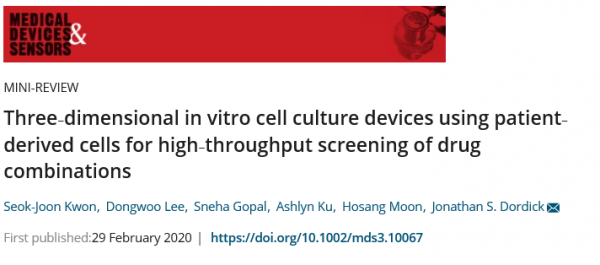Paper 2020, Medical Devices & Sensors, Three‐dimensional in vitro cell cultu…
Page Info

Contents
Abstract
Drug discovery using traditional animal models is often inefficient because test animal models cannot accurately represent human responses, particularly in terms of toxicology and pathophysiology. For these reasons, there is an urgent need to develop in vitro human disease models to accelerate new drug development. This is especially the case for precision medicine, where current in vitro and ex vivo models are not sufficient to predict individual drug efficacy and safety across the enormous heterogeneity of populations and individuals. In addition, model cell lines cultured under non‐physiological conditions do not recapitulate the complex microenvironment of patient tissues. Precision medicine using patient‐derived cells and drug combination therapies may be a promising solution to overcome these limitations. Three‐dimensional (3D) cell culture models can simultaneously simulate complex in vivo tissue microenvironments and be miniaturized for large‐scale screening of drug combinations using limited available patient‐derived cells. Recently, microfluidic and microarray platforms have been developed to mimic multiple human organs and human‐specific disease states, and are becoming more commonly used in high‐throughput drug screening. Herein, we highlight the current status of microfluidic‐based 3D cell culture devices, such as organ/body‐on‐chip systems, as well as microarray‐based 3D cell culture platforms, which can be combined with patient‐derived cells. Miniaturized cell culture systems using patient‐derived cells represent promising tools for identifying new drug combinations and also biological mechanisms that underlie drug synergies.
Drug discovery using traditional animal models is often inefficient because test animal models cannot accurately represent human responses, particularly in terms of toxicology and pathophysiology. For these reasons, there is an urgent need to develop in vitro human disease models to accelerate new drug development. This is especially the case for precision medicine, where current in vitro and ex vivo models are not sufficient to predict individual drug efficacy and safety across the enormous heterogeneity of populations and individuals. In addition, model cell lines cultured under non‐physiological conditions do not recapitulate the complex microenvironment of patient tissues. Precision medicine using patient‐derived cells and drug combination therapies may be a promising solution to overcome these limitations. Three‐dimensional (3D) cell culture models can simultaneously simulate complex in vivo tissue microenvironments and be miniaturized for large‐scale screening of drug combinations using limited available patient‐derived cells. Recently, microfluidic and microarray platforms have been developed to mimic multiple human organs and human‐specific disease states, and are becoming more commonly used in high‐throughput drug screening. Herein, we highlight the current status of microfluidic‐based 3D cell culture devices, such as organ/body‐on‐chip systems, as well as microarray‐based 3D cell culture platforms, which can be combined with patient‐derived cells. Miniaturized cell culture systems using patient‐derived cells represent promising tools for identifying new drug combinations and also biological mechanisms that underlie drug synergies.
Related Links
- Prev
 2020, Oral Oncology, A rapid quantification of invasive phenotype in head and neck squamous cell carcinoma: A novel 3D pillar array system 20.05.27
2020, Oral Oncology, A rapid quantification of invasive phenotype in head and neck squamous cell carcinoma: A novel 3D pillar array system 20.05.27 - Next
 2019, Journal of Experimental & Clinical Cancer Research, Multiplex quantitative analysis of stromamediated cancer cell invasion, matrix remodeling, and drug response in a 3D coculture model of pancreatic tumor spheroids and stellate cells 20.05.27
2019, Journal of Experimental & Clinical Cancer Research, Multiplex quantitative analysis of stromamediated cancer cell invasion, matrix remodeling, and drug response in a 3D coculture model of pancreatic tumor spheroids and stellate cells 20.05.27

